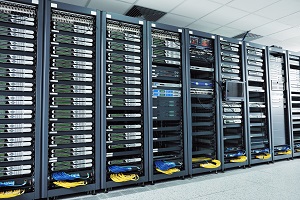 Outfitting, maintaining and managing a data center can be an expensive, time-consuming and labor-intensive process – one which may be beyond the budgetary or human resources of smaller-scale enterprises. In other instances, an organization’s data management and processing needs may not warrant the investment in a full-blown data center of their own.
Outfitting, maintaining and managing a data center can be an expensive, time-consuming and labor-intensive process – one which may be beyond the budgetary or human resources of smaller-scale enterprises. In other instances, an organization’s data management and processing needs may not warrant the investment in a full-blown data center of their own.
For circumstances like these, co-location offers a viable option.
What Is Co-Location?
Co-location is the process whereby an organization rents data center facilities for its servers and other hardware. Also known as a colocation or colo, the words describe both the practice and the buildings and environment being rented.
A colo typically supplies the physical premises, electrical power, cooling systems, network bandwidth, and on-site security by way of a hosted service, leaving customers with the responsibility for transporting in their own network hardware and related devices. Space rental may occur on a per room, cage, rack, or cabinet basis, and many providers now offer ancillary business services to round out their offerings.
Why It’s Worth Considering
There’s generally a huge capital expenditure required for constructing, managing, and maintaining a data center, and many small to medium-sized enterprises may find that this burden exceeds their available budget. A well-managed colocation offers![]() an affordable and viable alternative.
an affordable and viable alternative.
A colo can provide growing businesses with the flexibility and scalability they require – without the need for investing in more office space or IT staff when expansion is called for. All-in-one service plans ensure that physical space, bandwidth, and security may be scaled up in a single operation. This also streamlines budgeting, as one payment covers all the services being rented.
Co-location data centers are typically situated in remote, low-risk physical environments (where they’re able to negotiate competitive rates for power and infrastructure provision), and feature enhanced security measures such as video surveillance, armed guards, biometric scanners, and access codes. These measures are included in the service plan, and will generally exceed any provision that small to medium-sized business owners might be able to put in place on their own premises.
Colocations have had a tradition of providing Disaster Recovery (DR) backup and storage facilities for private corporations. But with the rise in popularity of cloud services, many providers now look to them to provide infrastructure and facilities for rental to their various clients.
Drawbacks And Challenges
The physical distance between an organization’s own premises and its colocation may introduce prohibitive transportation costs for both the initial transfers of hardware, and any subsequent visits by its staff (who also need to be transported, and paid) required for maintenance or configuration.
Contracts for colocation tend to be long-term, and clients may find themselves locked in with a particular provider, and unable to re-negotiate terms when market conditions force prices down in other areas.
There may also be hidden costs implicit within a Service Level Agreement (SLA), such as:
· Costs for cleaning and janitorial services at the colocation site
· Charges for backup power systems
· Fees for environmental services
· Salary payments for on-site security guards
· Ad hoc charges for third party consultants called in to attend to problems at the colo site generally, or in a client’s allocated area
· Surcharges for network bandwidth
· Wage payments for colocation site staff
The following recommendations should make your transition to a colocation and your use of its services less stressful.
Choose Your Data Center Wisely
Take an inventory of your resources, and identify your operational and business requirements. If moving to new physical premises, look for a data center that’s close to your current location, with 24/7 access for your staff in the event of tune-ups or general maintenance. Close proximity to your off-site data center can have a beneficial effect on the latency of network infrastructure, applications and workloads that require communication between sites.
Confirm For Security And Compliance
Besides ensuring that your colo isn’t located in a zone that’s frequently subject to earthquakes, brush fires, or other natural disasters, you’ll need to make sure that the physical and network security measures put in place by the provider are adequate both to your operational needs and the requirements of any regulatory regimes that you have to maintain compliance with.
If you’re co-locating to a cloud-based infrastructure, this condition should extend to any third-party suppliers or consultants that your colocation provider deals with.
Check For Uptime, Redundancy, And Reliability
Service Level Agreements with your colocation provider should guarantee 100% uptime – and this will be contingent on the levels of redundancy that your provider can ensure. Beyond the uptime guarantees, look for redundant power provision for high-density applications, and on-site cooling systems with good reliability.
Check For Levels Of Expertise
Due diligence will assist in determining how dependable and capable your colocation provider’s staff may be. Check testimonials and reviews to ensure that the provider you choose has a solid reputation for delivering high performance from the IT infrastructure in its care – and that its staff are well versed in addressing the needs of your organization, and the particular requirements of your sector and its compliance regimes.
Ask For Local Support
A 24/7 “remote hands” service![]() is what to look for, here: An experienced support staff that’s able to monitor and deal with hardware and infrastructure problems within minutes of a phone call – in addition to the support and redundancy measures for internet access and power that should come as standard. This level of service may be called upon to supplement the capabilities of your own IT support team.
is what to look for, here: An experienced support staff that’s able to monitor and deal with hardware and infrastructure problems within minutes of a phone call – in addition to the support and redundancy measures for internet access and power that should come as standard. This level of service may be called upon to supplement the capabilities of your own IT support team.
Collaborate And Crowd-Source
As a way of rounding out their service offerings, many providers now make a form of social networking![]() available to their colocation clients. They offer a platform for client organizations to interact with each other, and thus form partnerships, collaborate on projects or the solving of technical issues, and crowd-source talent.
available to their colocation clients. They offer a platform for client organizations to interact with each other, and thus form partnerships, collaborate on projects or the solving of technical issues, and crowd-source talent.
Conditions vary from supplier to supplier, so shop around to find a service that’s appropriate for you.
Go For The Full Package
Don’t be seduced by the apparent savings of a service plan that only offers electricity and space in the data center. A full service offering with space, facility maintenance, cooling, power, and security – without additional hidden charges – is the better way to go.